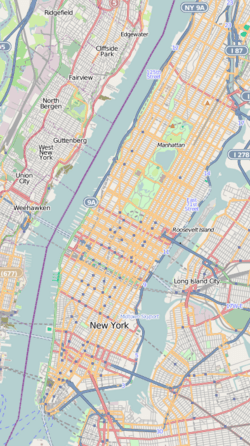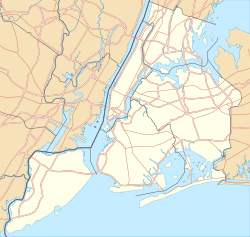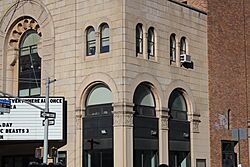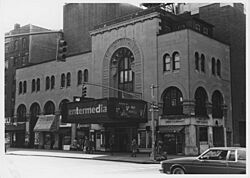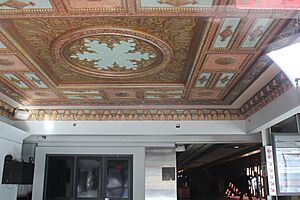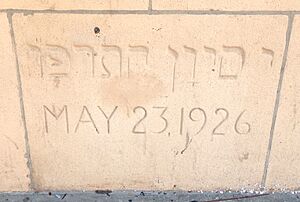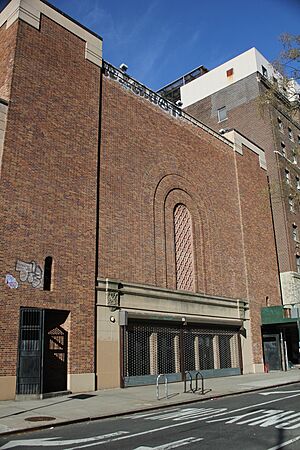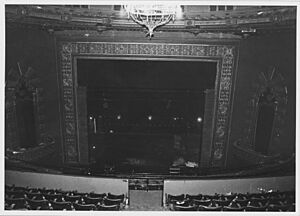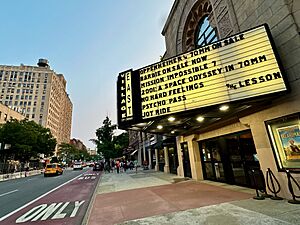Village East by Angelika facts for kids
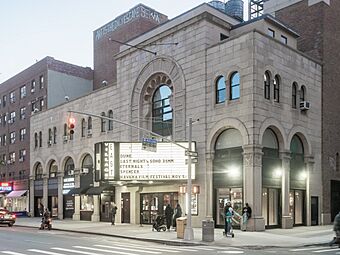 |
|
| Former names |
List
Louis N. Jaffe Theater
Yiddish Art Theatre (1926–1928, 1932–1934) Yiddish Folks Theatre (1928–1937) Molly Picon's Folks Theatre (1930–1931) Germans' Folks Theatre (1931–1932) Century Theatre (1937–1946) New Jewish Folk Theatre (1944–1945) Stuyvesant Theatre (1946–1953) Phoenix Theatre (1953–1961) Casino East Theater (1961–1965) Gayety Theater (1965–1969) Eden Theater (1969–1976) 12th Street Cinema (1976–1977) Entermedia Theater (1977–1985) Second Avenue Theater (1985–1988) Village East Cinema (1991–2021) |
|---|---|
| Address | 181–189 Second Avenue |
| Location | East Village, Manhattan, New York City |
| Coordinates | 40°43′51″N 73°59′11″W / 40.73083°N 73.98639°W |
| Public transit | New York City Subway: |
| Owner | Senyar Holding Company |
| Operator | City Cinemas (Reading International); Angelika Film Center |
| Type | Yiddish, Off-Broadway |
| Screens | 7 |
| Current use | Movie theater |
| Construction | |
| Architect | Harrison Wiseman |
|
Yiddish Art Theatre
|
|
| Location | 189 Second Avenue, New York, New York |
| Area | 12,077 sq ft (1,122.0 m2) |
| Built | 1926 |
| Architect | Harrison G. Wiseman |
| Architectural style | Moorish |
| NRHP reference No. | 85002427 |
| Significant dates | |
| Added to NRHP | September 19, 1985 |
Village East by Angelika is a historic movie theater in the East Village neighborhood of New York City. It sits on the corner of Second Avenue and 12th Street. The theater was originally built from 1925 to 1926 as the Louis N. Jaffe Art Theatre. It was designed in the beautiful Moorish Revival style, which was inspired by buildings in Spain and North Africa.
Over the years, this theater has had many different lives. It started as a home for Yiddish theatre, which are plays performed in the Yiddish language. It later hosted off-Broadway shows, which are smaller plays than those on Broadway. Since 1991, it has been a seven-screen movie theater. Because of its amazing history and design, the building is a New York City designated landmark and is listed on the National Register of Historic Places.
The theater has a grand entrance on Second Avenue and a large auditorium in the back. The original auditorium had a single large stage and seating area. Today, the orchestra level and stage have been cleverly divided into six smaller movie screens, while the grand balcony has been preserved as the main theater.
Contents
Design and Architecture
The Village East theater was built for a famous Yiddish Art Theatre group led by Maurice Schwartz. The building was designed by architect Harrison Wiseman. It was the only theater in the area built specifically for a Yiddish theater company. Today, it is the last remaining Yiddish theater building on Second Avenue.
The Building's Exterior
The front of the theater on Second Avenue features a series of seven large arches. The main entrance is the largest arch, decorated with beautiful patterns. Above the glass doors is a triangular sign called a marquee. A special stone, called a cornerstone, is set into the wall. It has the date May 23, 1926, written in both English and Hebrew.
The other arches once held storefronts. Today, some of these spaces are used for ticket counters and an indoor staircase. The third floor has pairs of small, arched windows. The side of the building along 12th Street is made of brick and has large exit doors.
The Theater's Interior
The inside of the theater is decorated with gold, blue, and cream colors. Many designs were inspired by the famous Alhambra palace in Spain. The decorations include elements of Jewish and Islamic art. Even though the theater's layout has changed, most of the original decorations are still there.
Lobbies and Promenade
The theater has two main lobbies. The main lobby on Second Avenue has a stunning ceiling with a large medallion in the center. When the theater became a movie multiplex, this lobby was expanded. It now includes a concession stand and an exhibit about the history of Yiddish theatre.
The second lobby, along 12th Street, has ornate chandeliers and walls that look like stone. From this lobby, two curved staircases lead up to a walkway, or promenade, behind the balcony seats.
The Auditorium
The auditorium is where the audience sits. It originally had a single sloping floor called an orchestra, a large balcony, and special seating areas called boxes. The stage was at the front, below a large arch called a proscenium.
In 1990, the theater was turned into a multiplex with seven screens.
- The balcony became the largest and most beautiful theater, known as Screen 1.
- The original orchestra area was divided into smaller theaters.
- The old stage area was also split into two screens, one above the other.
The side walls of the auditorium are made of textured plaster. The front of the balcony is decorated with flower-like designs called rosettes. The most amazing feature is the ceiling. It has a huge, shallow dome that is 40 feet across. In the center of the dome is a Star of David design and a large chandelier. The rest of the ceiling looks like a honeycomb, with detailed plaster moldings.
History of the Theater
In the late 1800s, many Jewish immigrants moved to New York City's East Village. This led to the creation of the Yiddish Theatre District on Second Avenue. It was a lively area filled with theaters showing plays in the Yiddish language.
A Home for Yiddish Art
In 1925, a community leader named Louis N. Jaffe decided to build a special theater for Maurice Schwartz's Yiddish Art Theatre. The cornerstone was laid in a special ceremony on May 23, 1926. Jaffe wanted the theater to be a monument to the contributions of Jewish immigrants.
The Louis N. Jaffe Art Theatre officially opened on November 17, 1926. The first show was The Tenth Commandment. The opening night was a huge event, attended by many famous people.
For nearly 20 years, the theater was a major center for Yiddish culture. It hosted plays, musicals, and operettas. However, after just two seasons, Maurice Schwartz's company moved out. The theater was then used by other groups and was known by different names, like the Yiddish Folks Theatre. Famous performers like Molly Picon and Menasha Skulnik appeared on its stage.
By the late 1930s, Yiddish theatre was becoming less popular. Many younger Jewish people were speaking English and blending into American culture. In 1937, the theater was turned into a movie house called the Century Theatre. It briefly returned to showing Yiddish plays in the early 1940s but became a full-time movie theater again in 1946, renamed the Stuyvesant Theatre.
A New Life as the Phoenix Theatre
In 1953, a new chapter began. Two producers, Norris Houghton and T. Edward Hambleton, leased the theater and created the Phoenix Theatre. Their goal was to create high-quality off-Broadway shows at affordable prices. This was a big deal because it helped make theater more accessible to everyone.
The Phoenix Theatre was very successful in its first season. It presented famous plays like Coriolanus and The Seagull. The company stayed at the theater until 1961. Its presence helped revive Second Avenue as a theatrical hub.
Different Shows and New Names
After the Phoenix Theatre left, the building went through many changes.
- Casino East Theater (1961): It showed a popular variety show called This Was Burlesque.
- Gayety Theater (1965): It became Manhattan's only theater for variety and comedy shows.
- Eden Theater (1969): It hosted the famous modern revue Oh! Calcutta!. Later, hit musicals like Man of La Mancha and Grease played here.
- Entermedia Theater (1977): It showed a mix of films, dance, and experimental plays. The hit musical The Best Little ... in Texas started here before moving to Broadway.
- Second Avenue Theater (1985): It continued to host off-Broadway shows.
By the late 1980s, the theater closed again. It was the last surviving Yiddish theater building on Second Avenue. Many people worried about its future.
Becoming Village East
In 1988, City Cinemas leased the building with a plan to save it. They decided to turn it into a modern movie theater while preserving its historic beauty. The renovation was carefully done to protect the original design. The balcony was kept as one large theater, while the lower level was divided into smaller screens.
The Village East Cinemas opened in 1991. In 1993, the building's exterior and interior were officially protected as New York City landmarks. This ensures that its amazing architecture will be saved for future generations to enjoy.
In 2021, the theater was rebranded as Village East by Angelika. It continues to show a mix of popular Hollywood movies and independent films. It also sometimes hosts special screenings of classic movies, connecting audiences to the magic of film history in a truly historic setting.
See also


